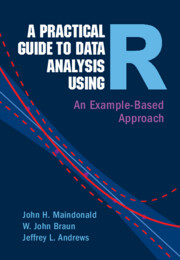Book contents
- Frontmatter
- Dedication
- Contents
- Figures
- Preface
- 1 Learning from Data, and Tools for the Task
- 2 Generalizing from Models
- 3 Multiple Linear Regression
- 4 Exploiting the Linear Model Framework
- 5 Generalized Linear Models, and Survival Analysis
- 6 Time Series Models
- 7 Multilevel Models, and Repeated Measures
- 8 Tree-Based Classification and Regression
- 9 Multivariate Data Exploration and Discrimination
- Appendix A The R System: a Brief Overview
- References
- References to R Packages
- Index of R Functions
- Index of Terms
8 - Tree-Based Classification and Regression
Published online by Cambridge University Press: 11 May 2024
- Frontmatter
- Dedication
- Contents
- Figures
- Preface
- 1 Learning from Data, and Tools for the Task
- 2 Generalizing from Models
- 3 Multiple Linear Regression
- 4 Exploiting the Linear Model Framework
- 5 Generalized Linear Models, and Survival Analysis
- 6 Time Series Models
- 7 Multilevel Models, and Repeated Measures
- 8 Tree-Based Classification and Regression
- 9 Multivariate Data Exploration and Discrimination
- Appendix A The R System: a Brief Overview
- References
- References to R Packages
- Index of R Functions
- Index of Terms
Summary
Tree-based methods use methodologies that are radically different from those discussed in previous chapters. They are relatively easy to use and can be applied to a wide class of problems. As with many of the new machine learning methods, construction of a tree, or (in the random forest approach, trees) follows an algorithmic process. Single-tree methods occupy the first part this chapter. An important aspect of the methodology is the determining of error estimates. By building a large number of trees and using a voting process to make predictions, the random forests methodology that occupies the latter part of this chapter can often greatly improve on what can be achieved with a single tree. The methodology operates more as a black box, but with implementation details that are simpler to describe than for single- tree methods. In large sample classification problems, the methodology has often proved superior to other contenders.
Keywords
Information
- Type
- Chapter
- Information
- A Practical Guide to Data Analysis Using RAn Example-Based Approach, pp. 373 - 399Publisher: Cambridge University PressPrint publication year: 2024
